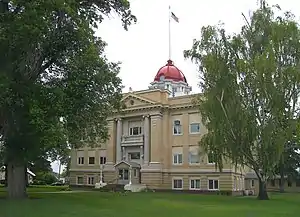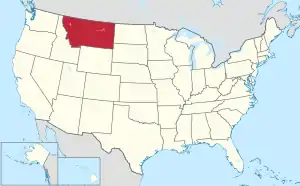Richland County, Montana
Richland County is a county in the U.S. state of Montana. As of the 2020 census, the population was 11,491.[2] Its county seat is Sidney.[3]
Richland County | |
|---|---|
 Richland County Courthouse in Sidney | |
 Location within the U.S. state of Montana | |
 Montana's location within the U.S. | |
| Coordinates: 47°47′N 104°34′W | |
| Country | |
| State | |
| Founded | May 27, 1914[1] |
| Seat | Sidney |
| Largest city | Sidney |
| Area | |
| • Total | 2,103 sq mi (5,450 km2) |
| • Land | 2,084 sq mi (5,400 km2) |
| • Water | 19 sq mi (50 km2) 0.9% |
| Population (2020) | |
| • Total | 11,491 |
| • Estimate (2022) | 11,237 |
| • Density | 5.5/sq mi (2.1/km2) |
| Time zone | UTC−7 (Mountain) |
| • Summer (DST) | UTC−6 (MDT) |
| Congressional district | 2nd |
| Website | www |
| |
Richland County was created by the Montana Legislature in 1914 from part of Dawson County. An early proposed name for the county was Gate, but Richland was decided upon instead as a way to entice new settlers.[4]
Geography
According to the United States Census Bureau, the county has a total area of 2,103 square miles (5,450 km2), of which 2,084 square miles (5,400 km2) is land and 19 square miles (49 km2) (0.9%) is water.[5]
Major highways
Adjacent counties
- Roosevelt County – north
- Williams County, North Dakota – northeast
- McKenzie County, North Dakota – east
- Wibaux County - south
- Dawson County – southwest
- McCone County - west
Demographics
| Census | Pop. | Note | %± |
|---|---|---|---|
| 1920 | 8,989 | — | |
| 1930 | 9,633 | 7.2% | |
| 1940 | 10,209 | 6.0% | |
| 1950 | 10,366 | 1.5% | |
| 1960 | 10,504 | 1.3% | |
| 1970 | 9,837 | −6.3% | |
| 1980 | 12,243 | 24.5% | |
| 1990 | 10,716 | −12.5% | |
| 2000 | 9,667 | −9.8% | |
| 2010 | 9,746 | 0.8% | |
| 2020 | 11,491 | 17.9% | |
| 2022 (est.) | 11,237 | [6] | −2.2% |
| U.S. Decennial Census[7] 1790-1960[8] 1900-1990[9] 1990-2000[10] 2010-2020[2] | |||
2020 census
As of the census of 2020, there were 11,491 people.
2010 census
As of the census of 2010, there were 9,746 people, 4,167 households, and 2,698 families in the county. The population density was 4.7 inhabitants per square mile (1.8/km2). There were 4,550 housing units at an average density of 2.2 per square mile (0.85/km2). The racial makeup of the county was 95.0% white, 1.7% American Indian, 0.2% Asian, 0.1% black or African American, 0.8% from other races, and 2.1% from two or more races. Those of Hispanic or Latino origin made up 3.0% of the population. In terms of ancestry, 37.8% were German, 23.1% were Norwegian, 13.0% were Irish, 8.7% were American, and 6.5% were English.
Of the 4,167 households, 28.9% had children under the age of 18 living with them, 51.9% were married couples living together, 7.6% had a female householder with no husband present, 35.3% were non-families, and 29.8% of all households were made up of individuals. The average household size was 2.33 and the average family size was 2.88. The median age was 41.3 years.
The median income for a household in the county was $52,516 and the median income for a family was $60,236. Males had a median income of $44,788 versus $23,135 for females. The per capita income for the county was $26,888. About 10.2% of families and 13.5% of the population were below the poverty line, including 16.6% of those under age 18 and 14.4% of those age 65 or over.
Economy
Although most of the surface land of the county is devoted to ranching, oil exploration and production became important elements of the county's economy beginning with the discovery in 2000 of Elm Coulee Oil Field, part of the Bakken formation.[11]
Politics
Richland County voters have been reliably Republican, opting only one time for the Democratic Party candidate in national elections since 1948 (as of 2020).
| Year | Republican | Democratic | Third party | |||
|---|---|---|---|---|---|---|
| No. | % | No. | % | No. | % | |
| 2020 | 4,800 | 82.79% | 875 | 15.09% | 123 | 2.12% |
| 2016 | 3,908 | 80.23% | 671 | 13.78% | 292 | 5.99% |
| 2012 | 3,510 | 75.52% | 1,002 | 21.56% | 136 | 2.93% |
| 2008 | 3,184 | 70.50% | 1,203 | 26.64% | 129 | 2.86% |
| 2004 | 3,110 | 72.19% | 1,120 | 26.00% | 78 | 1.81% |
| 2000 | 2,858 | 70.87% | 1,018 | 25.24% | 157 | 3.89% |
| 1996 | 2,021 | 44.24% | 1,614 | 35.33% | 933 | 20.42% |
| 1992 | 1,760 | 37.07% | 1,440 | 30.33% | 1,548 | 32.60% |
| 1988 | 2,628 | 57.81% | 1,824 | 40.12% | 94 | 2.07% |
| 1984 | 3,847 | 72.85% | 1,382 | 26.17% | 52 | 0.98% |
| 1980 | 3,348 | 66.45% | 1,252 | 24.85% | 438 | 8.69% |
| 1976 | 2,189 | 51.35% | 1,961 | 46.00% | 113 | 2.65% |
| 1972 | 2,645 | 61.51% | 1,438 | 33.44% | 217 | 5.05% |
| 1968 | 2,381 | 59.29% | 1,399 | 34.84% | 236 | 5.88% |
| 1964 | 1,784 | 43.19% | 2,320 | 56.16% | 27 | 0.65% |
| 1960 | 2,395 | 56.10% | 1,863 | 43.64% | 11 | 0.26% |
| 1956 | 2,366 | 55.67% | 1,884 | 44.33% | 0 | 0.00% |
| 1952 | 2,506 | 67.28% | 1,196 | 32.11% | 23 | 0.62% |
| 1948 | 1,332 | 43.11% | 1,673 | 54.14% | 85 | 2.75% |
| 1944 | 1,347 | 42.61% | 1,777 | 56.22% | 37 | 1.17% |
| 1940 | 1,497 | 41.07% | 2,095 | 57.48% | 53 | 1.45% |
| 1936 | 1,066 | 28.99% | 2,516 | 68.43% | 95 | 2.58% |
| 1932 | 1,216 | 39.02% | 1,768 | 56.74% | 132 | 4.24% |
| 1928 | 1,648 | 63.53% | 917 | 35.35% | 29 | 1.12% |
| 1924 | 926 | 49.95% | 238 | 12.84% | 690 | 37.22% |
| 1920 | 1,759 | 65.46% | 744 | 27.69% | 184 | 6.85% |
| 1916 | 1,223 | 36.51% | 1,947 | 58.12% | 180 | 5.37% |
See also
References
- Greenfield, Chas. (1920). Resources of Montana (1920 ed.). Montana. Dept. of Agriculture, Labor, and Industry. p. 174. Retrieved September 1, 2023.
- "State & County QuickFacts". United States Census Bureau. Retrieved April 5, 2023.
- "Find a County". National Association of Counties. Archived from the original on May 31, 2011. Retrieved June 7, 2011.
- "Montana Place Names Companion". Montana Place Names From Alzada to Zortman. Montana Historical Society Research Center. Retrieved May 9, 2011.
- "2010 Census Gazetteer Files". United States Census Bureau. August 22, 2012. Archived from the original on December 5, 2014. Retrieved November 29, 2014.
- "Annual Estimates of the Resident Population for Counties: April 1, 2020 to July 1, 2022". Retrieved April 5, 2023.
- "U.S. Decennial Census". United States Census Bureau. Retrieved November 29, 2014.
- "Historical Census Browser". University of Virginia Library. Retrieved November 29, 2014.
- "Population of Counties by Decennial Census: 1900 to 1990". United States Census Bureau. Retrieved November 29, 2014.
- "Census 2000 PHC-T-4. Ranking Tables for Counties: 1990 and 2000" (PDF). United States Census Bureau. Archived (PDF) from the original on March 27, 2010. Retrieved November 29, 2014.
- Browning, Gil. "Montana's Vast Untapped Oil Reserves". Archived from the original on February 23, 2014. Retrieved February 10, 2014.
- Leip, David. "US Presidential Elections". uselectionatlas.org. Retrieved April 3, 2018.
- Andes MT Google Maps (accessed January 5, 2019)
- Enid MT Google Maps (accessed January 5, 2019)
- Nohly MT Google Maps (accessed January 5, 2019)
- Ridgelawn MT Google Maps (accessed January 5, 2019)
- Sioux Pass MT Google Maps (accessed January 5, 2019)